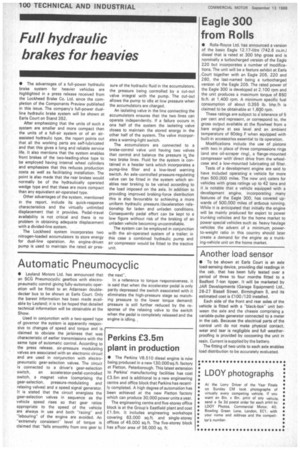Eagle 300 from Rolls
Page 102

If you've noticed an error in this article please click here to report it so we can fix it.
• Rolls-Royce Ltd. has announced a version of the basic Eagle 12.17-litre 1742.6 cu.in.) diesel that is rated at 300 bhp gross and is nominally a turbocharged version of the Eagle 220 but incorporates a number of modifications. The unit will be a feature exhibit at Earls Court together with an Eagle 205, 220 and 260, the last-named being a turbocharged version of the Eagle 205. The rated power of the Eagle 300 is developed at 2,100 rpm and the unit produces a maximum torque of 850 lb.ft. at 1,400 rpm. A minimum specific fuel consumption of about 0.355 lb. bhp /h is claimed to be obtainable at 1,600 rpm.
These ratings are subject to a tolerance of 5 per cent and represent, or correspond to, the gross output available at the flywheel from a bare engine at sea level and an ambient temperature of 60deg F when equipped with built-in accessories essential to its operation.
Modifications include the use of pistons with two in place of three compressions rings (and one oil-scraper ring), a flange-mounted compressor with direct drive from the wheelcase and a low-mounted lubricating oil filter.
Tests of a development engine are said to have included operating a vehicle for more than 500,000 miles. The new unit caters for vehicles with gross ratings up to 42 tons and it is notable that a vehicle equipped with a development engine, incorporating many features of the Eagle 300, has covered upwards of 500,000 miles of arduous running. While it is anticipated that initially the engine will be mainly produced for export to power trunking vehicles and for the home market to power special vehicles such as heavy haulage vehicles the advent of a minimum, powerto-weight ratio in this country should later create a demand for the engine as a trun king-vehicle unit on the home market.




































































































































































































































































